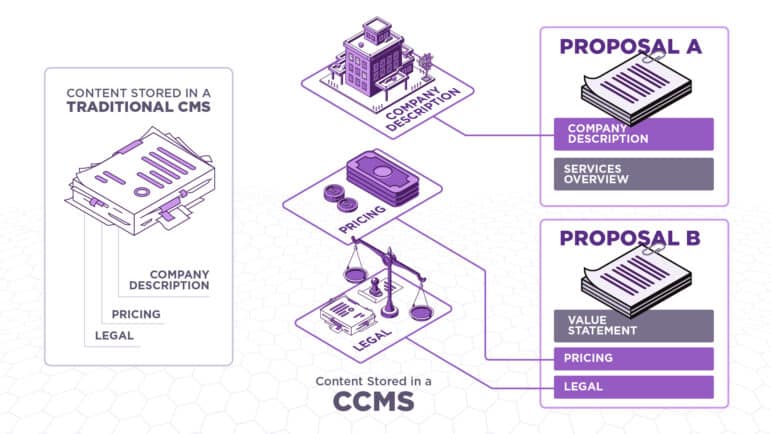If you work on a content or technology team, you may have heard about Component Content Management Systems (CCMS) and wondered, “do we need that?” CCMSs have grown in popularity over the past few years and have begun to prove their worth as a valuable content management technology for many organizations. What is the buzz about, and why might a CCMS help further your content goals?
What are CCMSs?
Fundamentally, CCMSs are content management systems that manage content at a component level as opposed to a document level. To break that down further, let’s first define how traditional content management systems (CMS) store content. Traditional CMSs store and tag content by document, even if it consists of many different elements or topics within it. A CCMS, on the other hand, stores content as components that can be combined to build documents dynamically. These components can be thought of as the smaller chunks of content that make up a larger document. For example, a proposal writing team might leverage components to reuse elements of proposals and prevent the need to write from scratch during each effort. The company description, pricing, and legal section might all be separate components that can be selected and reused in as many proposals as needed. This granular level of management creates opportunities to leverage and reuse content in new and valuable ways. Teams no longer have to spend time either searching for and then copy-pasting content from one document to another or simply writing new content. With a CCMS, content teams know they have pre-written and approved sets of content components they can rely on when composing and publishing new content.
Signs a CCMS is Right for Your Org
Below are a few factors that you can use to assess if a CCMS is right for your organization.
- Your users need to find pieces of information quickly. Search experience can be improved immensely with a CCMS. For example, users in a call center or help desk environment need to quickly and authoritatively respond to customer questions and requests. If they have to make multiple clicks and scrolls to get to the information they need and then have to spend time assessing whether they’ve found the correct information, this consumes precious time during customer interaction. A CCMS can serve specific, scannable information to users based on their search terms so that they more quickly arrive at the answer they’re looking for. This is especially powerful when users have to navigate through numerous versions of similar information, like product-specific guides or State by State laws/policies.
- Users have to “Ctrl-F” to find what they need within documents. If your users frequently access documents that require performing a search within the document itself to drill down on a topic, a componentized content strategy, and consequently a CCMS, can revolutionize the way they interact with this content. Similar to the previous use case in which users can find small pieces of information more quickly through enterprise search, large documents can be componentized in order to save users time and clicks finding information.
- Content frequently needs to be updated in multiple places. Research, laws, best practices, and other information related to specific knowledge domains are constantly evolving. The impetus is on content teams to maintain and update their organization’s content when new information becomes available. A CCMS allows users to edit components in one place and then push the update to all of the content it appears in their systems. This saves time and ensures that components are uniformly and accurately updated across all of the content it is a part of.
- You are looking to implement a Knowledge Graph or advanced search application. A CCMS provides an excellent head start to implementing cutting-edge content management and search functionality. Content components can be used to assemble intuitive, specific search results and even underpin functionality like a knowledge panel. Check out one of the ways EK paired a CCMS with a knowledge graph to produce a flexible, adaptive, and customized content experience for a financial solutions provider.
- You are looking to implement more personalization. Customers have come to expect that the content they receive is contextualized for their specific needs. Audience groups would rather receive specific pieces of content relevant to their interests than longer documents that they need to spend time combing through to find the right information for them. A CCMS lets content teams compose personalized content by making it easy to assemble content using only components relevant to different audience groups. To dig into this further, read about how a CCMS paired with a Knowledge Graph can take personalization to the next level.
CCMSs have value beyond the use cases listed here, but this should get you thinking about how a CCMS might fit into your content ecosystem. You can read another example of how EK partnered with an organization to implement a CCMS here. If you are ready to explore CCMSs, EK has experts ready to advise on and implement a strategy that is best for you.

